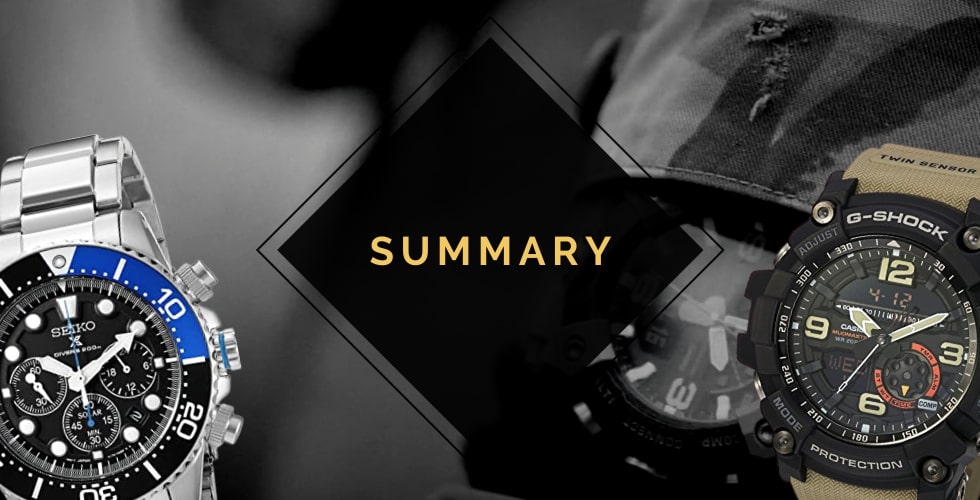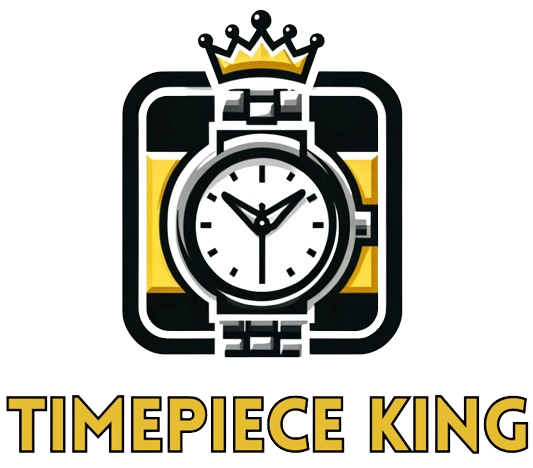Outside of the world’s capital of the watchmaking industry (Switzerland, naturally), the Japanese watch market is probably the one that offers the best value. In general, Japanese watches are definitely more affordable than Swiss ones, but they don’t sacrifice quality – on the contrary, some of the most popular watch brands in the world come from Japan.
Two of those brands are Casio and Seiko. Both have been around for ages, both offer a vast array of different models at different price points, and both are known for their quality.
With that said, there are probably more differences than similarities between the two. Each brand appeals to a different audience, offers different design solutions and materials, and focuses on different technologies.
To help you decide which brand is better suited for your needs, we’ve created this in-depth Casio vs Seiko comparison. We’ll be looking at the brands’ background, history, style, quality of materials, movements, and, finally, prices.
So, are Casio or Seiko watches better? Without further delay, let’s go.
Seiko vs Casio: Background & History
Let’s start with a short yet insightful look into both brands’ roots.
As an affiliate, Timepieceking might earn a commission (at no additional cost to you) for purchases made via links in the article.
For a quick peek at some of the best-selling models:
Seiko
A quick look at the brand’s history reveals that Seiko has been in the watchmaking business for over a century. The company started out in 1881 as a watch and clock repair shop in the Ginza district of Tokyo and soon started manufacturing its own products.
In 1917, Seiko produced Japan’s first wristwatch, and in 1924 – the country’s first pocket watch with a minute hand. This was also the year when Seiko introduced its first brand name – Laurel.
In 1957, Seiko released the world’s first quartz wristwatch, the Astron. This event not only had a huge impact on the company itself but on the watchmaking industry as a whole. Quartz watches quickly became more accurate and more affordable than their mechanical counterparts, and Seiko became known as a pioneer of quartz technology.
For a much more detailed look into Seiko’s milestone-rich history, read our Seiko brand review.
Casio
Casio, on the other hand, has a shorter but no less impressive history. The company was founded in 1946 by Tadao Kashio, an electrical engineer who developed the world’s first all-electric compact calculator. Hence, the company started out as a manufacturer of calculators and other electronics, but they eventually ventured into watchmaking.
In 1974, Casio released the world’s first digital watch with an LED display. This was a game-changer for the company, and it soon became one of the world’s most popular watch brands.
In the 1980s, Casio started experimenting with different technologies and materials, which resulted in the release of the world’s first watch with a built-in TV (the TV-400) and the world’s first G-Shock watch. To this day, G-Shock watches are considered the biggest trademark of Casio.
Seiko vs Casio: Style
When it comes to style, Seiko and Casio watches are about as different as they can be. Seiko watches are generally more conservative and elegant, while Casio watches tend to be more modern and experimental.
This is most evident in the brands’ flagship lines. Seiko’s luxury line – Grand Seiko – features classic, elegant designs that wouldn’t look out of place in a board meeting or a black-tie event.
Casio’s main line – G-Shock – on the other hand, is all about modernity, ruggedness and functionality. These watches are designed to be tough and durable, and they often feature unique, innovative designs. Not without a reason, they’re a popular choice amongst people in the military or other demanding professions such as firefighters, police officers, or EMTs.
Of course, this is not to say that all Seiko watches are dressy and all Casio watches are sporty. There are plenty of models in both brands’ catalogs that can be classified as either dress or sports watches. It’s just that Seiko tends to focus more on the former, while Casio – on the latter.
Seiko vs Casio: Materials & Durability
When it comes to the quality of materials, both Seiko and Casio use a mix of high-end and mass-produced parts.
For example, Seiko’s Grand Seiko collection features watches with cases made out of 18k gold, platinum or titanium, while their more budget-friendly lines use stainless steel or ceramic.
Similarly, Casio’s G-Shock line is known for its use of durable materials like carbon fiber and titanium, but the brand also offers more affordable models made out of plastic.
What’s essential, both brands offer excellent protection for the most damage-prone part of any watch – the dial window.
Outside Casio‘s bargain-basement line which comes with plastic dials (<$30), most Casio models utilize scratch-resistant mineral crystal. A small portion of timepieces come with sapphire crystal which is the most durable glass type used by the very top players.
When it comes to Seiko, none of the watches come with anything less than a Hardlex crystal – Seiko’s proprietary glass type. On the durability scale, it’s closer to mineral than sapphire. Seiko’s mid-to-high-end watches offer sapphire glass, however.
So, in terms of the materials, we can say that both brands are on a similar page. It really depends on your budget and your preferences as to which brand you would consider being the better choice.
However, when it comes to general durability and the ability to literally take a beating, Casio watches, particularly the G-Shock line, have an upper hand. All G-Shocks offer best-in-the-industry protection against shocks, and their water resistance is also generally on point (upwards of 666 feet/200m).
With Seiko, only the dive watch collection can offer that level of protection against water damage. The shock-absorbing system is also thought to be a bit weaker.
Seiko vs Casio: Movements
On the movement front, Seiko offers a much more diversified profile.
Seiko watches utilize all types of movements – from battery-powered (quartz) to automatic to manual (hand-wound). This gives the customer a lot of choices when it comes to picking a watch.
Casio, on the other hand, relies solely on battery-powered (quartz) movements. These are the go-to type if your priority is excellent accuracy. Most quartz watches offered by Casio are unlikely to lose or gain more than 15-30 seconds per month.
So, if you’re looking for a watch with a specific type of movement, Seiko is probably the better brand to go with. However, if you don’t have a preference in this department, then both brands are equally good choices and the final decision will depend on other features.
What’s worth noting, Seiko itself is a popular movement manufacturer whose mechanisms are used by timepieces of many other watchmakers. One of their most popular calibers is 7s26, which is used in many of the brand’s entry-level watches – particularly in Seiko’s dive watch and Seiko 5 collections. It’s a simple, accurate and reliable movement, but it doesn’t offer any special features or complications.
That’s not to say that Casio doesn’t deserve any praise for its movements. The brand offers a wide range of digital and analog-digital watch movements, many of which feature unique complications and functions. For example, the Casio G-Shock line is known for its use of radio-controlled and solar-powered movements.
So, in terms of movement selection, Seiko is the more traditional brand, while Casio is the more innovative option. Again, it really depends on your preferences as to which brand you would consider the better choice.
Seiko vs Casio: Prices
Finally, let’s take a look at the prices of Seiko and Casio watches.
As you would expect, Seiko’s luxury line – Grand Seiko – is the most expensive, with some models costing several thousand dollars. However, the brand also offers many entry-level and mid-range models that are very affordable. Prices for low-budget Seiko watches start around the $100 mark. However, the vast majority of models can be found in the $200-$500 price basket.
- Read Also: Top Affordable Seiko Watches
Casio, on the other hand, is generally more budget-friendly, with most of its models costing less than $200. Of course, there are also some high-end G-Shock models that can cost upwards of $1000, but they are the exception rather than the rule.
- Read Also: Top Affordable G-Shock Watches
So, in terms of price, Seiko is the more expensive brand, but it also offers a wider range of prices, from entry-level to luxury. Casio, on the other hand, is generally more affordable, but its selection of high-end models is more limited.
Seiko vs Casio: Warranty
Finally, let’s take a look at the warranty policies of Seiko and Casio.
Seiko offers a three-year warranty on all of its watches, regardless of price or model. This warranty covers manufacturing defects, but not damage caused by normal wear and tear or accidents.
Casio also offers a two-year warranty on all of its watches, but this can be extended to three or more years for an additional fee. The warranty covers manufacturing defects and damage caused by normal wear and tear, but not accidents.
So, in terms of warranty coverage, Seiko is probably the safer choice, as it offers a longer warranty period for all of its models. Casio’s warranty period is shorter, but it can be extended for an additional fee.
Which Is Better: Casio or Seiko? Conclusion

Seiko and Casio are two of the most popular watch brands in the world. Both brands have a long history and tradition of excellence, and they offer a wide range of products at different price points.
So, which is better: Seiko or Casio? In truth, there is no easy answer. It really depends on your individual needs and preferences.
If you’re looking for a traditional, sometimes luxurious watch, then Seiko is the better choice. However, if you’re looking for a more affordable, functional watch, then Casio is the way to go.
Whatever your needs, one thing is certain – you can’t go wrong with either of these two brands.
If you’d like to further expand your knowledge of the Japanese watch industry, we encourage you to read our Seiko & Citizen brand comparison.

